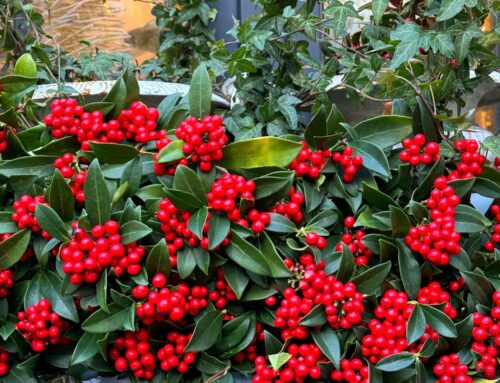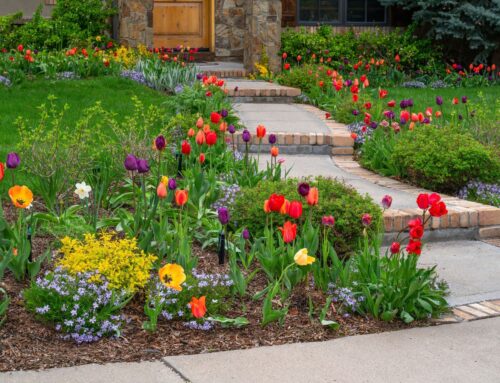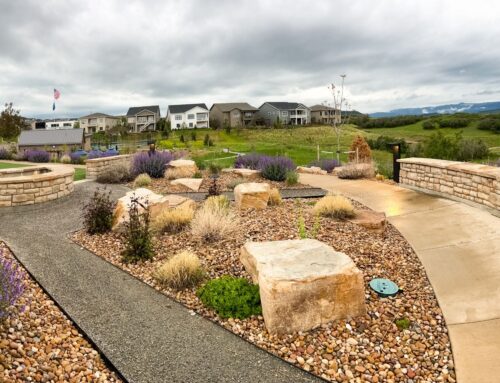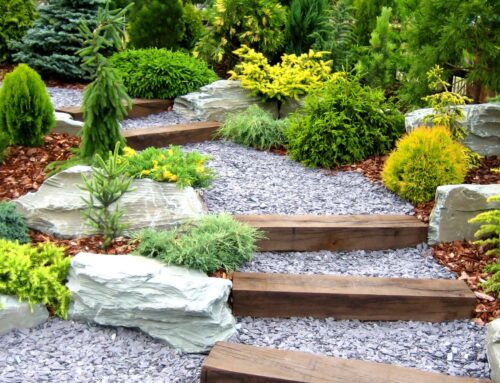Different Types of Landscaping Rocks
When you think about landscaping, chances are your first thoughts involve choosing the right plants or flowers. But another essential design element is incorporating different types of landscaping rocks. From decorative accents to functional features, rocks can enhance visual appeal, control drainage, and create structure. Understanding the various landscaping rocks types available helps you choose the right type of landscape rock for your needs.
Types of Landscaping Rocks: Guide to Common Landscaping Rock Options
You can choose a single type of rock or add several different types of landscaping rocks based on your particular needs. Here are some of the different types of landscaping rocks that are available.
Large Stones
Large stones come in a variety of sizes. The smallest stones will be about the size of a soccer ball and the largest about the size of a small car. These large stones can be used as a decorative piece or they can be functional. If you place a large rock at the edge of your driveway it can block people from driving into your garden. Placed alone, a large stone can provide a focal point for your landscaping. You can choose to plant some flowers around the stone to make it even more dramatic. If you have a waterfall feature or a pond, adding a large stone will provide you with a more natural look.
River Rock
River rocks are stones that are rounded. These rocks are typically between a quarter-inch to six inches in size. Small and medium-sized river rocks can be used as mulch for plants that love heat or for French drains. These rocks also work around plants that are located in shady areas.
If your plants do not heat tolerant, you should not use river rock around them. These stones will retain the warmth from the sun and can overheat plants that are sensitive to heat. Placing large or medium-sized river rocks along a path can create a path that looks like a river bed. This type of rock looks very attractive when placed at the base of a large stone.
Gravel
Gravel may refer to either pea gravel or crushed gravel. Pea gravel is made of small smooth pebbles and offers a great visual appeal. This type of gravel is often used in a Japanese garden to create the look of a pond. This is also a good choice for traffic pathways but needs to be used with edging in order to keep the pea gravel in place.
It also is a great mulch for container plants as it will not retain heat well so it will not cause your plants to overheat. Crushed gravel is best for unpaved driveways or for a layer in a French drain. It should not be used in areas where people will walk because it has rough edges.
Lava Rock
The bright color of lava rock is attractive to many gardeners. It can be used to fill in driveways. Lava rock is a good choice if you have cactus or yucca plants in an arid garden. The coarse texture of lava rock can hurt your feet, so it is best not to use it in areas where people might be walking barefoot.
Flagstones
If you are going to make a path or want to build a patio, flagstones are a perfect choice. Flagstone is a rock that is wide and flat, which is why they are the perfect stepping stone. If you are laying a path or a patio with flagstone it is important to make sure that you place the stones over the sand to provide a more stable surface with proper drainage. Creeping thyme and another low growing ground cover can be placed in the spaces between the stones to help create a more natural look.
The type of rock that is available to you will depend on where you live. Decorative stone is taken from quarries, and the types of stone will vary greatly by your location. Shipping stone from other areas can be quite expensive and is often not worth the price tag.
Comparison of Common Landscaping Rock Types
Type of Landscape Rock |
Description |
Best Use |
|---|---|---|
Large Stones |
Boulder-sized rocks that add focal points or block traffic |
Decor, driveways, pond edges |
River Rock |
Smooth, rounded stones of various sizes |
Mulch, French drains, walkways |
Pea Gravel |
Small, smooth pebbles |
Walkways, gardens, container plant mulch |
Crushed Gravel |
Jagged-edged stones |
Driveways, drainage layers |
Lava Rock |
Porous, red or black volcanic stone |
Cactus beds, xeriscaping |
Flagstone |
Flat, wide slabs of rock |
Patios, stepping paths |
Choosing the right type of landscape rock depends on your climate, aesthetic preferences, and intended function. Mixing different landscaping rocks types can also help you achieve balance and texture across your entire design.
How to Choose the Right Type of Landscape Rock
With so many types of landscaping rocks to choose from, narrowing down the best option for your yard depends on several factors:
-
Function: Do you need rock for pathways, drainage, or decoration?
-
Climate: Some rocks retain heat (like river rock), while others like pea gravel stay cooler.
-
Maintenance: Larger rocks and flagstone require little care, while gravel may shift or need edging.
-
Style: Consider color and texture. Lava rock has a dramatic look, while river rocks feel more natural.
If you’re unsure which type of landscape rock is best, working with a landscape designer can help you create a well-balanced, sustainable plan.
SOLMAUNA Creations & Landscaping Designs in Colorado
Our team of landscape designers brings a unique combination of landscape architecture education paired with extensive knowledge of plants to the table. Contact us Today.
Different Types of Landscaping Rocks
When you think about landscaping, chances are your first thoughts involve choosing the right plants or flowers. But another essential design element is incorporating different types of landscaping rocks. From decorative accents to functional features, rocks can enhance visual appeal, control drainage, and create structure. Understanding the various landscaping rocks types available helps you choose the right type of landscape rock for your needs.
Types of Landscaping Rocks: Guide to Common Landscaping Rock Options
You can choose a single type of rock or add several different types of landscaping rocks based on your particular needs. Here are some of the different types of landscaping rocks that are available.
Large Stones
Large stones come in a variety of sizes. The smallest stones will be about the size of a soccer ball and the largest about the size of a small car. These large stones can be used as a decorative piece or they can be functional. If you place a large rock at the edge of your driveway it can block people from driving into your garden. Placed alone, a large stone can provide a focal point for your landscaping. You can choose to plant some flowers around the stone to make it even more dramatic. If you have a waterfall feature or a pond, adding a large stone will provide you with a more natural look.
River Rock
River rocks are stones that are rounded. These rocks are typically between a quarter-inch to six inches in size. Small and medium-sized river rocks can be used as mulch for plants that love heat or for French drains. These rocks also work around plants that are located in shady areas.
If your plants do not heat tolerant, you should not use river rock around them. These stones will retain the warmth from the sun and can overheat plants that are sensitive to heat. Placing large or medium-sized river rocks along a path can create a path that looks like a river bed. This type of rock looks very attractive when placed at the base of a large stone.
Gravel
Gravel may refer to either pea gravel or crushed gravel. Pea gravel is made of small smooth pebbles and offers a great visual appeal. This type of gravel is often used in a Japanese garden to create the look of a pond. This is also a good choice for traffic pathways but needs to be used with edging in order to keep the pea gravel in place.
It also is a great mulch for container plants as it will not retain heat well so it will not cause your plants to overheat. Crushed gravel is best for unpaved driveways or for a layer in a French drain. It should not be used in areas where people will walk because it has rough edges.
Lava Rock
The bright color of lava rock is attractive to many gardeners. It can be used to fill in driveways. Lava rock is a good choice if you have cactus or yucca plants in an arid garden. The coarse texture of lava rock can hurt your feet, so it is best not to use it in areas where people might be walking barefoot.
Flagstones
If you are going to make a path or want to build a patio, flagstones are a perfect choice. Flagstone is a rock that is wide and flat, which is why they are the perfect stepping stone. If you are laying a path or a patio with flagstone it is important to make sure that you place the stones over the sand to provide a more stable surface with proper drainage. Creeping thyme and another low growing ground cover can be placed in the spaces between the stones to help create a more natural look.
The type of rock that is available to you will depend on where you live. Decorative stone is taken from quarries, and the types of stone will vary greatly by your location. Shipping stone from other areas can be quite expensive and is often not worth the price tag.
Comparison of Common Landscaping Rock Types
Type of Landscape Rock |
Description |
Best Use |
|---|---|---|
Large Stones |
Boulder-sized rocks that add focal points or block traffic |
Decor, driveways, pond edges |
River Rock |
Smooth, rounded stones of various sizes |
Mulch, French drains, walkways |
Pea Gravel |
Small, smooth pebbles |
Walkways, gardens, container plant mulch |
Crushed Gravel |
Jagged-edged stones |
Driveways, drainage layers |
Lava Rock |
Porous, red or black volcanic stone |
Cactus beds, xeriscaping |
Flagstone |
Flat, wide slabs of rock |
Patios, stepping paths |
Choosing the right type of landscape rock depends on your climate, aesthetic preferences, and intended function. Mixing different landscaping rocks types can also help you achieve balance and texture across your entire design.
How to Choose the Right Type of Landscape Rock
With so many types of landscaping rocks to choose from, narrowing down the best option for your yard depends on several factors:
-
Function: Do you need rock for pathways, drainage, or decoration?
-
Climate: Some rocks retain heat (like river rock), while others like pea gravel stay cooler.
-
Maintenance: Larger rocks and flagstone require little care, while gravel may shift or need edging.
-
Style: Consider color and texture. Lava rock has a dramatic look, while river rocks feel more natural.






